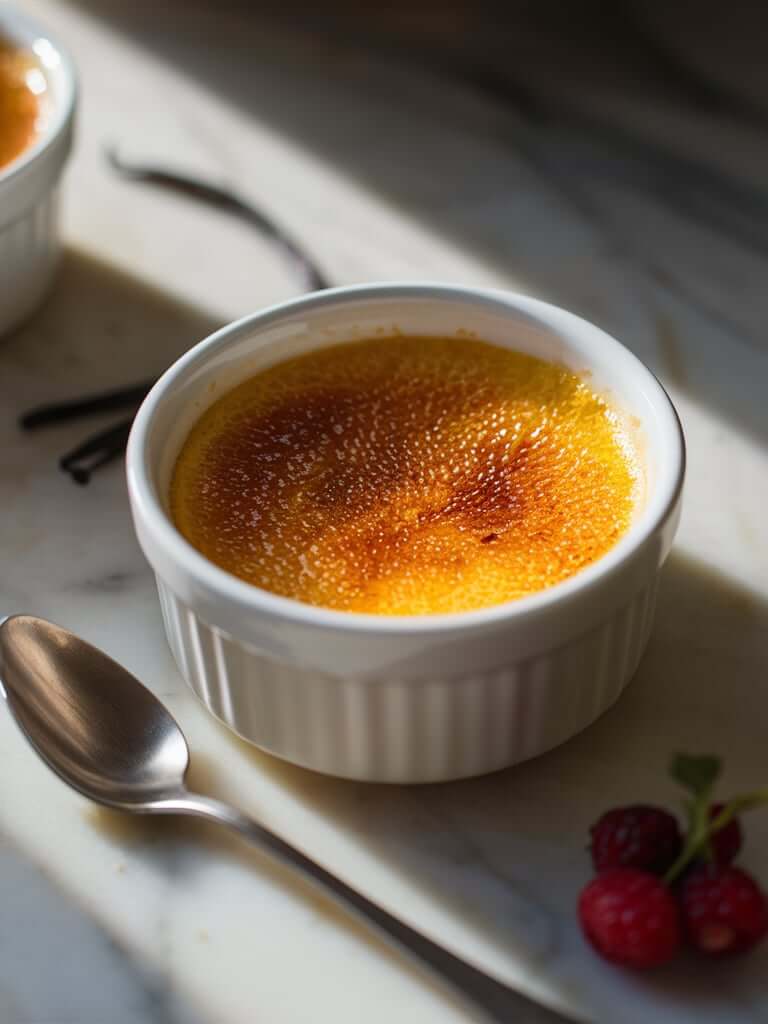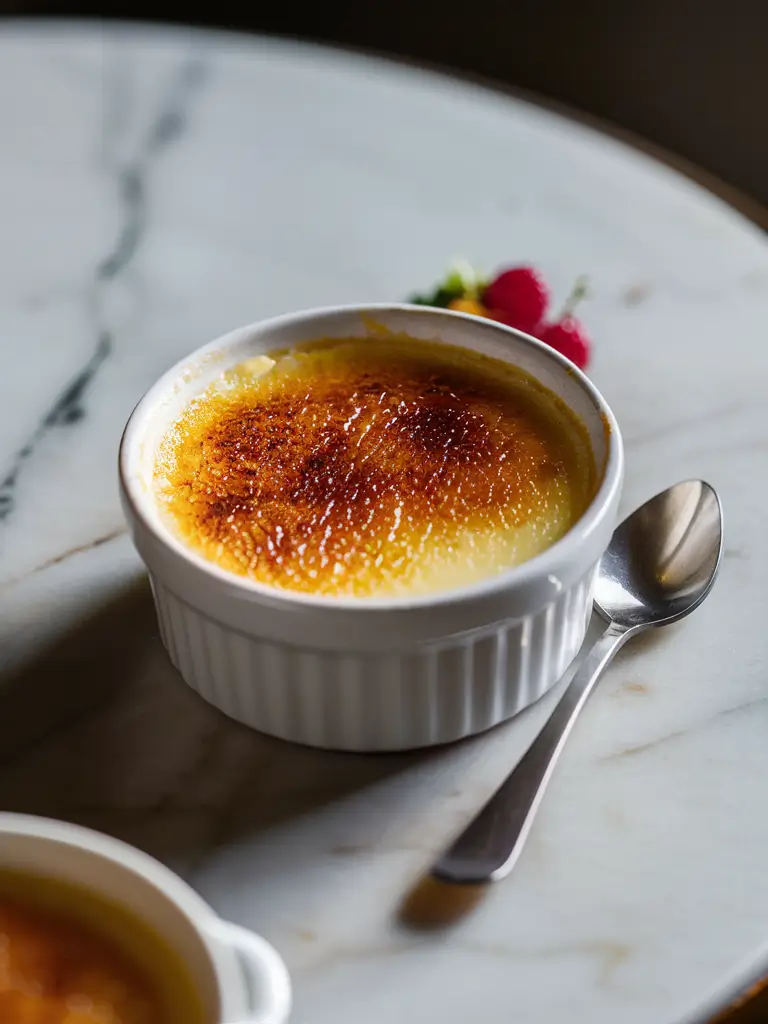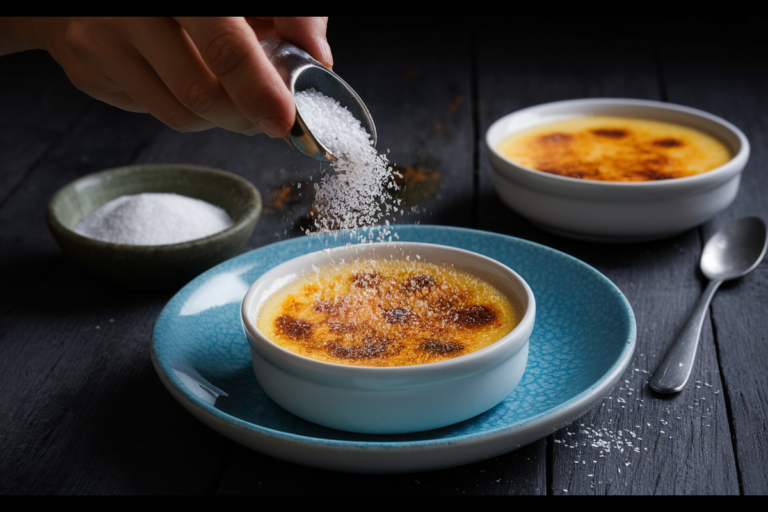Crème brûlée is one of the most iconic desserts that perfectly embodies the phrase “simple yet elegant.” A classic French dessert, crème brûlée, meaning “burnt cream,” is known for its creamy custard base topped with a contrasting layer of hard caramelized sugar. Despite its simple list of ingredients, perfecting this dessert can be challenging. In this article, we will reveal the secret to crème brûlée, from selecting the best ingredients to mastering the caramelization process. We’ll also explore the history of this decadent treat, provide expert tips, and address frequently asked questions.
1. Introduction to Crème Brûlée
Crème brûlée, with its rich, creamy custard base and brittle caramelized sugar topping, is a dessert that many aspire to perfect. This treat is not only delicious but also visually stunning, often serving as the highlight of a fine dining experience. While the dish seems straightforward, achieving the perfect balance of texture and flavor requires careful attention to detail. The key secret to crème brûlée lies in mastering each step, from the choice of ingredients to the precise method of caramelizing the sugar. Whether you’re a seasoned chef or an enthusiastic home cook, understanding the intricacies of this dish will elevate your culinary skills.
2. A Brief History of Crème Brûlée
The origins of crème brûlée are somewhat contested, with claims from France, Spain, and England. The earliest known recipe appeared in a French cookbook in 1691, where it was called “crème à l’Angloise,” or “English cream.” The modern name, crème brûlée, directly translates to “burnt cream,” referring to the signature caramelized sugar topping.
In Spain, a similar dessert called crema catalana has been enjoyed since at least the 18th century, often flavored with citrus and cinnamon. Meanwhile, in England, a dish called “Trinity Cream” was popularized in the 19th century at Trinity College, Cambridge, featuring a similar custard topped with burnt sugar.
Despite its debated origins, crème brûlée is now firmly entrenched in French cuisine and beloved worldwide.
The origins of crème brûlée are somewhat contested, with France, Spain, and England all laying claim to its invention. Learn more about its fascinating history in The Oxford Companion to Sugar and Sweets.
3. The Key Ingredients in Crème Brûlée
The beauty of crème brûlée lies in its simplicity. The dish requires only a few key ingredients, yet each plays a crucial role in the final product. Understanding the role of each ingredient is a vital secret to crème brûlée success:
Heavy Cream
Heavy cream is the backbone of the crème brûlée custard, providing richness and a silky texture. It’s essential to use high-quality heavy cream with a fat content of at least 36%. The fat is necessary to achieve the desired creamy consistency and to prevent the custard from curdling during baking.
- Substitutes: While heavy cream is the traditional choice, you can substitute it with half-and-half for a lighter version, though the texture may not be as rich.
Egg Yolks
Egg yolks are another critical component, responsible for thickening the custard. The proteins in the yolks coagulate during baking, transforming the liquid mixture into a soft, set custard. It’s important to use fresh, high-quality eggs for the best flavor and texture.
- Tips: Separate the egg yolks carefully to avoid any whites, which could affect the custard’s texture. Using cold eggs can make separation easier.
Sugar
Sugar serves two main purposes in crème brûlée: sweetening the custard and creating the caramelized topping. The amount of sugar used in the custard can be adjusted to taste, but the sugar for the topping should always be superfine or caster sugar for even caramelization.
- Types of Sugar: Granulated sugar is typically used for the custard, while superfine sugar is ideal for the topping. Some chefs prefer using turbinado sugar for the topping, which adds a deeper caramel flavor.
Vanilla Beans or Extract
Vanilla is the primary flavoring in traditional crème brûlée. Using a whole vanilla bean offers the most intense flavor and adds an attractive speckling to the custard. However, high-quality vanilla extract can be used as a substitute.
- Tips: If using a vanilla bean, split it lengthwise and scrape out the seeds to infuse the cream fully. The empty pod can also be added to the cream during heating for extra flavor.
“Vanilla beans are an essential ingredient in crème brûlée, adding depth and richness to the flavor. For a deeper dive into the cultural significance of vanilla, check out this article from Smithsonian Magazine.”
4. Essential Tools for Making Crème Brûlée
To achieve the best results, it’s important to have the right tools on hand. Here are the essentials:
- Ramekins: Small, shallow dishes made of ceramic, glass, or porcelain. Ramekins should be between 4 to 6 ounces in capacity to ensure even cooking.
- Kitchen Torch: A handheld butane torch is ideal for caramelizing the sugar topping evenly. If you don’t have one, the broiler in your oven can be used, though it’s less precise.
- Whisk: A sturdy whisk is necessary for mixing the custard ingredients without incorporating too much air.
- Fine-Mesh Sieve: Straining the custard through a fine-mesh sieve ensures a silky smooth texture by removing any lumps or curdled bits.
- Baking Dish: A deep dish or roasting pan to hold the ramekins during baking in a water bath.

5. The Step-by-Step Process of Making Crème Brûlée
Understanding the process is another critical secret to crème brûlée success. Here’s how to make it step by step:
Preparing the Custard Base
- Heat the Cream: Begin by gently heating the heavy cream in a saucepan over medium heat until it just starts to simmer. Do not let it boil. If using a vanilla bean, add it to the cream before heating to infuse the flavor.
- Whisk the Egg Yolks and Sugar: In a separate bowl, whisk together the egg yolks and granulated sugar until the mixture is pale and slightly thickened.
- Temper the Eggs: Slowly pour a small amount of the hot cream into the egg mixture while continuously whisking. This process, known as tempering, prevents the eggs from scrambling. Gradually add the rest of the cream, continuing to whisk until well combined.
- Strain the Mixture: Pour the custard mixture through a fine-mesh sieve into another bowl or a large measuring cup with a spout. This step ensures a smooth, lump-free custard.
Baking in a Water Bath
- Preheat the Oven: Set your oven to 325°F (160°C).
- Prepare the Water Bath: Place the ramekins in a deep baking dish. Pour the custard into the ramekins, filling them about three-quarters full. Carefully pour hot water into the baking dish until it reaches halfway up the sides of the ramekins. The water bath provides gentle, even heat, helping the custard cook evenly without cracking.
- Bake: Transfer the baking dish to the oven and bake for 30-40 minutes, or until the custards are just set around the edges but still slightly jiggly in the center.
- Cool: Remove the ramekins from the water bath and let them cool to room temperature. Then, refrigerate them for at least 2 hours, or overnight, to allow the custard to fully set.
Chilling and Setting
Chilling the custard is crucial for achieving the right texture. After baking, the custard should be refrigerated for at least a couple of hours, though overnight is preferable. This allows the flavors to meld and the custard to firm up.
Caramelizing the Sugar Topping
- Sprinkle Sugar: Once the custards are thoroughly chilled, sprinkle an even layer of superfine sugar on top of each one.
- Torch the Sugar: Using a kitchen torch, carefully caramelize the sugar by moving the flame in a circular motion until the sugar melts and forms a golden-brown crust. The sugar should bubble and harden as it cools.
- Let it Set: Allow the caramelized sugar to harden for a minute or two before serving.
6. Expert Tips for the Perfect Crème Brûlée
Mastering the secret to crème brûlée involves attention to detail. Here are some expert tips:
- Avoid Overbaking: Crème brûlée should have a slight jiggle in the center when you remove it from the oven. Overbaking will result in a rubbery texture.
- Control the Sugar: Use superfine or caster sugar for the topping. This sugar melts more evenly, creating a smooth caramelized layer.
- Patience is Key: Allow the custard to cool completely before caramelizing the sugar. If the custard is too warm, the sugar may not set properly.
Pair your perfectly caramelized crème brûlée with dishes like Tender BBQ Chicken Wings in the Slow Cooker for a truly satisfying meal.
7. Common Mistakes to Avoid
Avoiding common mistakes is part of the secret to crème brûlée:
- Skipping the Water Bath: The water bath is essential for even baking. Without it, the custard may cook unevenly, leading to curdling or cracking.
- Overmixing: When combining the egg yolks and sugar, mix just until combined. Overmixing can incorporate too much air, leading to a custard that’s too airy and not dense enough.
- Incorrect Sugar: Using regular granulated sugar for the topping may result in uneven caramelization. Opt for superfine sugar instead.
Caramelization is key to achieving the perfect sugar crust on your crème brûlée. To understand the science behind this process, visit the Exploratorium’s explanation.
8. Variations of Crème Brûlée
While the classic vanilla crème brûlée is a favorite, there are numerous variations to explore:
Chocolate Crème Brûlée
- Rich and decadent, chocolate crème brûlée is made by adding melted dark chocolate to the custard mixture before baking.
Coffee Crème Brûlée
- Adding espresso or instant coffee to the cream infuses the custard with a deep, robust flavor, perfect for coffee lovers.
Fruit-Infused Crème Brûlée
- Fruits such as raspberries, orange zest, or passion fruit can be added to the custard for a refreshing twist. These additions bring a burst of flavor and color to the traditional dessert.
9. Pairings and Serving Suggestions
Crème brûlée is a versatile dessert that pairs well with a variety of flavors. Here are some ideas:
- Beverage Pairings: A sweet dessert wine like Sauternes or a rich port complements the creamy texture and caramelized topping. For non-alcoholic options, consider a cup of strong coffee or a frothy cappuccino.
- Fruit Garnishes: Fresh berries, such as raspberries or blueberries, add a pop of color and a tart contrast to the sweetness of the custard.
- Textural Complements: Serve with a crisp biscotti or a small shortbread cookie on the side for added texture.
10. Health and Nutritional Insights
Crème brûlée, while indulgent, can be enjoyed as part of a balanced diet when consumed in moderation. Here are some nutritional considerations:
- Calories and Fat: Due to the heavy cream and egg yolks, crème brûlée is high in calories and fat. However, the richness of the dessert typically means that a small serving is satisfying.
- Sugar Content: The sugar content can be adjusted in the custard to suit your taste. Additionally, the caramelized sugar topping, while delicious, can be kept to a thin layer to reduce sugar intake.
- Substitutions: For a lighter version, consider using half-and-half instead of heavy cream, and opt for a sugar substitute like Stevia in the custard.
11. Storing and Reheating Crème Brûlée
Storing
- Refrigeration: Crème brûlée should be stored in the refrigerator, covered, for up to 3 days. The custard should be kept cool to maintain its texture.
- Without the Topping: If possible, store the custard without the sugar topping. Add and caramelize the sugar just before serving to ensure a crisp crust. secret to crème brûlée
Reheating
- Avoid Reheating: Reheating crème brûlée is not recommended as it can cause the custard to overcook and lose its texture. Instead, enjoy it chilled straight from the fridge. secret to crème brûlée
For a unique twist on this classic dessert, consider exploring other innovative recipes like Crab Brûlée.

12. FAQs
What is the best sugar for caramelizing the top of crème brûlée?
Superfine or caster sugar is the best choice for caramelizing crème brûlée. It melts quickly and evenly, creating a smooth, hard crust without the risk of burning unevenly. Some chefs also use turbinado sugar for a deeper caramel flavor.
How do I prevent my crème brûlée from curdling?
To prevent curdling, ensure you bake the custard in a water bath at a low temperature. Additionally, temper the egg mixture slowly by gradually adding the hot cream to avoid cooking the eggs too quickly.
Can I make crème brûlée without a kitchen torch?
Yes, you can use the broiler in your oven as an alternative. Place the ramekins under the broiler on the top rack and watch closely until the sugar melts and caramelizes. However, a kitchen torch provides more control and is less likely to overheat the custard.
Why did my crème brûlée crack?
Cracks in crème brûlée can occur if the custard is overbaked or cooled too quickly. Baking the custard in a water bath and allowing it to cool gradually at room temperature before refrigerating can help prevent cracking.
How do I know when my crème brûlée is done baking?
The crème brûlée is done when the custard is set around the edges but still slightly jiggly in the center. It should not be fully firm when removed from the oven, as it will continue to set as it cools.
13. Conclusion: Why Crème Brûlée Is Worth Mastering
Mastering crème brûlée is a rewarding endeavor for any home cook or aspiring chef. This classic French dessert not only impresses guests but also teaches fundamental cooking techniques, such as tempering eggs and caramelizing sugar. The creamy custard paired with the crisp caramelized topping creates a textural contrast that is simply irresistible. Once you’ve perfected the basic recipe, the world of crème brûlée variations is vast, offering endless opportunities for creativity in the kitchen.
Whether you enjoy it as a luxurious treat after a special meal or as a sophisticated addition to a dinner party, crème brûlée is a dessert that embodies the joy of cooking and the pleasure of indulgence.

